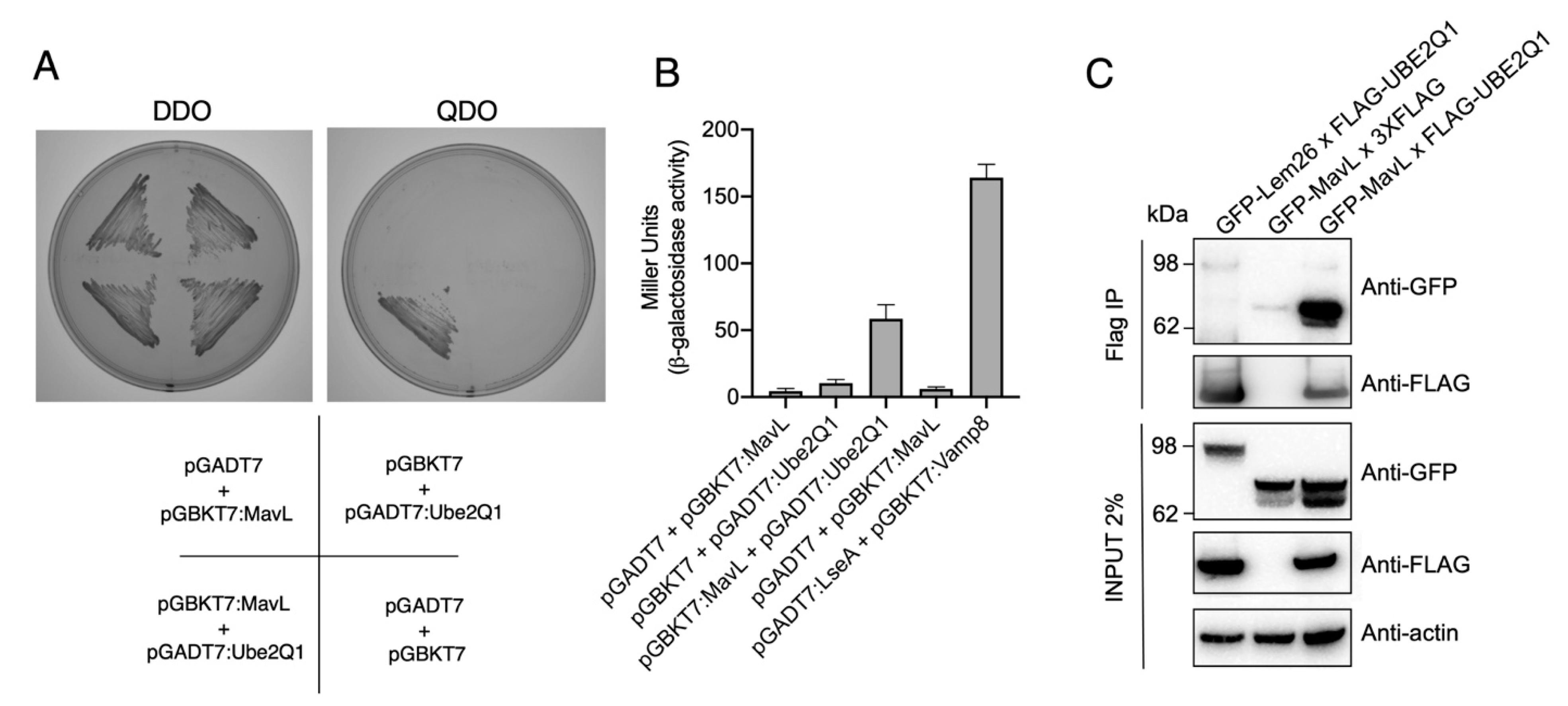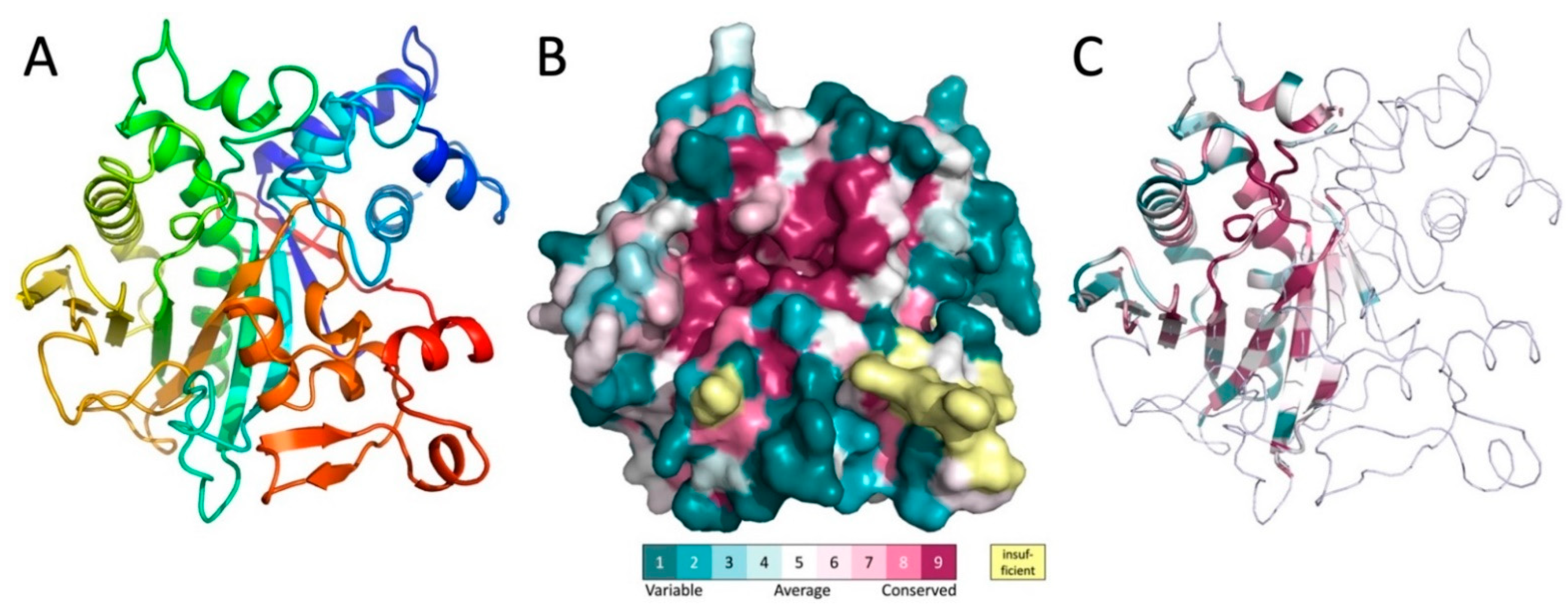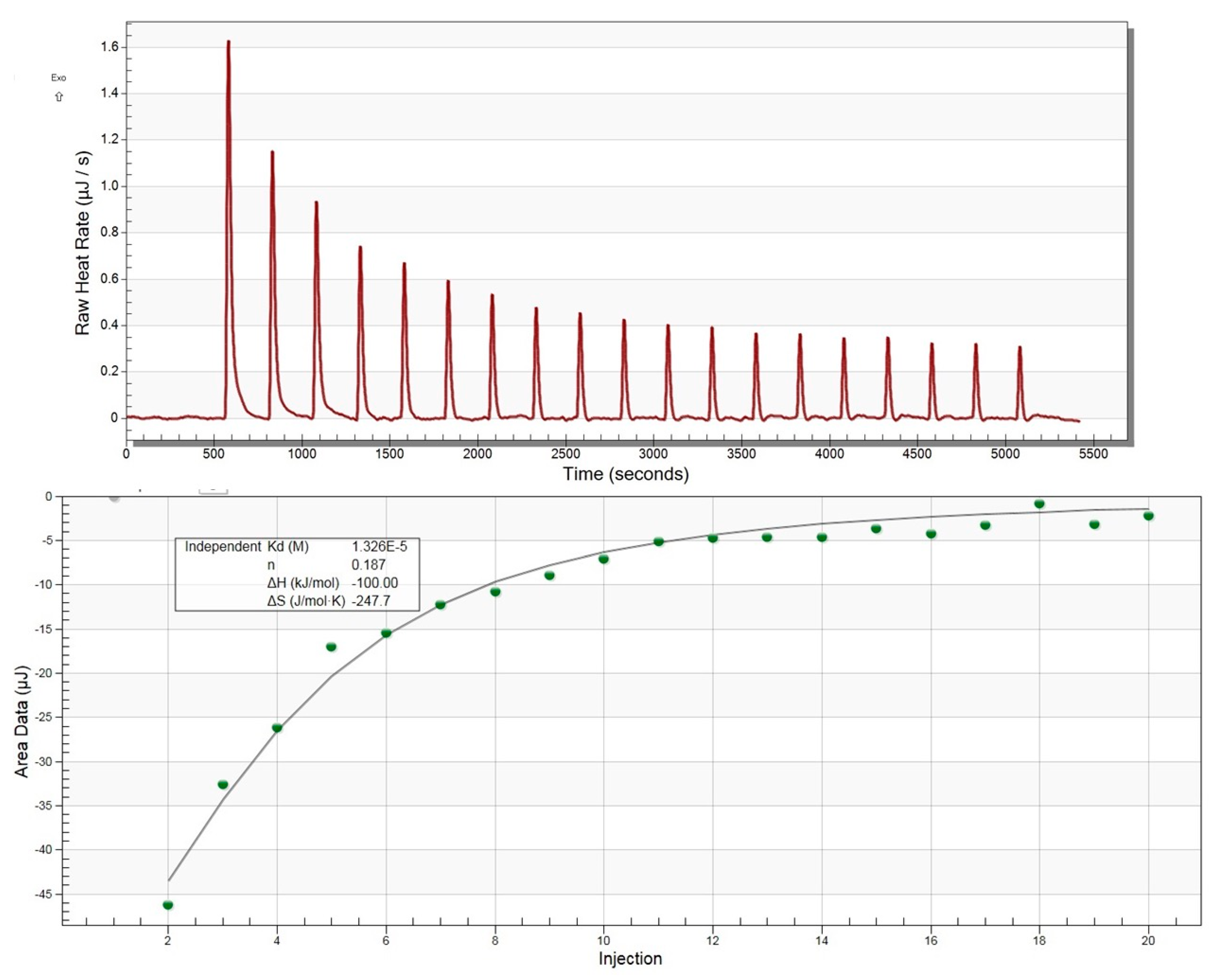Structural and Functional Characterization of Legionella pneumophila Effector MavL
Abstract
:1. Introduction
2. Materials and Methods
2.1. Bacterial Strains, Yeast Strains, and Growth Conditions
2.2. Tissue Culture of Human-Derived Immortalized Cells
2.3. Genetic Manipulation
2.4. TEM-1 Beta Lactamase Translocation Assay
2.5. Yeast Two-Hybrid Screening and Β-Galactosidase Assay
2.6. Co-Immunoprecipitation of EGFP and FLAG-Tagged Fusion Proteins
2.7. Immunoblotting
2.8. Immunofluorescence Microscopy
2.9. Cloning of Recombinant Mavl
2.10. Protein Expression and Purification
2.11. Crystallization of MavL(42-435)
2.12. Data Collection and Structure Determination
2.13. Isothermal Titration Calorimetry of MavL(42-435) with ADP-Ribose
3. Results
3.1. Cellular Localization of MavL
3.2. MavL Associates with E2 Conjugating Enzyme, UBE2Q1
3.3. Crystal Structure of MavL
3.4. Structural Homologs of MavL
3.5. MavL Is Not Only Structurally Similar to the ADP-Ribose-Binding Macrodomains, but It Also Binds ADP-Ribose
3.6. MavL Is Most Similar to ADPR Glycohydrolases
4. Discussion
Author Contributions
Funding
Institutional Review Board Statement
Informed Consent Statement
Data Availability Statement
Acknowledgments
Conflicts of Interest
References
- Mondino, S.; Schmidt, S.; Rolando, M.; Escoll, P.; Gomez-Valero, L.; Buchrieser, C. Legionnaires’ Disease: State of the Art Knowledge of Pathogenesis Mechanisms of Legionella. Annu. Rev. Pathol. 2020, 15, 439–466. [Google Scholar] [CrossRef] [PubMed] [Green Version]
- Ghosh, S.; O’Connor, T.J. Beyond Paralogs: The Multiple Layers of Redundancy in Bacterial Pathogenesis. Front. Cell. Infect. Microbiol. 2017, 7, 467. [Google Scholar] [CrossRef] [PubMed] [Green Version]
- Grishin, A.; Voth, K.; Gagarinova, A.; Cygler, M. Structural biology of the invasion arsenal of Gram-negative bacterial pathogens. FEBS J. 2021. [Google Scholar] [CrossRef] [PubMed]
- Huang, L.; Boyd, D.; Amyot, W.M.; Hempstead, A.D.; Luo, Z.-Q.; O’Connor, T.J.; Chen, C.; Machner, M.; Montminy, T.; Isberg, R.R. The E Block motif is associated with Legionella pneumophila translocated substrates. Cell. Microbiol. 2011, 13, 227–245. [Google Scholar] [CrossRef]
- Lifshitz, Z.; Burstein, D.; Peeri, M.; Zusman, T.; Schwartz, K.; Shuman, H.A.; Pupko, T.; Segal, G. Computational modeling and experimental validation of the Legionella and Coxiella virulence-related type-IVB secretion signal. Proc. Natl. Acad. Sci. USA. 2013, 110, E707–E715. [Google Scholar] [CrossRef] [Green Version]
- Gomez-Valero, L.; Rusniok, C.; Carson, D.; Mondino, S.; Pérez-Cobas, A.E.; Rolando, M.; Pasricha, S.; Reuter, S.; Demirtas, J.; Crumbach, J.; et al. More than 18,000 effectors in the Legionella genus genome provide multiple, independent combinations for replication in human cells. Proc. Natl. Acad. Sci. USA 2019, 116, 2265–2273. [Google Scholar] [CrossRef] [PubMed] [Green Version]
- Buchan, D.W.A.; Jones, D.T. The PSIPRED Protein Analysis Workbench: 20 years on. Nucleic Acids Res. 2019, 47, W402–W407. [Google Scholar] [CrossRef] [PubMed] [Green Version]
- Feeley, J.C.; Gibson, R.J.; Gorman, G.W.; Langford, N.C.; Rasheed, J.K.; Mackel, D.C.; Baine, W.B. Charcoal-yeast extract agar: Primary isolation medium for Legionella pneumophila. J. Clin. Microbiol. 1979, 10, 437–441. [Google Scholar] [CrossRef] [PubMed] [Green Version]
- Edelstein, P.H.; Nakahama, C.; Tobin, J.O.; Calarco, K.; Beer, K.B.; Joly, J.R.; Selander, R.K. Paleoepidemiologic investigation of Legionnaires disease at Wadsworth Veterans Administration Hospital by using three typing methods for comparison of legionellae from clinical and environmental sources. J. Clin. Microbiol. 1986, 23, 1121–1126. [Google Scholar] [CrossRef] [PubMed] [Green Version]
- Riedmaier, P.; Sansom, F.M.; Sofian, T.; Beddoe, T.; Schuelein, R.; Newton, H.J.; Hartland, E.L. Multiple ecto-nucleoside triphosphate diphosphohydrolases facilitate intracellular replication of Legionella pneumophila. Biochem. J. 2014, 462, 279–289. [Google Scholar] [CrossRef] [PubMed]
- Dolezal, P.; Aili, M.; Tong, J.; Jiang, J.-H.; Marobbio, C.M.; Lee, S.F.; Schuelein, R.; Belluzzo, S.; Binova, E.; Mousnier, A.; et al. Legionella pneumophila Secretes a Mitochondrial Carrier Protein during Infection. PLoS Pathog. 2012, 8, e1002459. [Google Scholar] [CrossRef]
- de Felipe, K.S.; Glover, R.T.; Charpentier, X.; Anderson, O.R.; Reyes, M.; Pericone, C.D.; Shuman, H.A. Legionella eukaryotic-like type IV substrates interfere with organelle trafficking. PLoS Pathog. 2008, 4, e1000117. [Google Scholar] [CrossRef] [PubMed]
- King, N.P.; Newton, P.; Schuelein, R.; Brown, D.L.; Petru, M.; Zarsky, V.; Dolezal, P.; Luo, L.; Bugarcic, A.; Stanley, A.C.; et al. Soluble NSF attachment protein receptor molecular mimicry by a Legionella pneumophila Dot/Icm effector. Cell. Microbiol. 2015, 17, 767–784. [Google Scholar] [CrossRef] [PubMed]
- Gietz, R.D.; Schiestl, R.H.; Willems, A.R.; Woods, R.A. Studies on the transformation of intact yeast cells by the LiAc/SS-DNA/PEG procedure. Yeast 1995, 11, 355–360. [Google Scholar] [CrossRef] [PubMed]
- Grochulski, P.; Fodje, M.N.; Gorin, J.; Labiuk, S.L.; Berg, R. Beamline 08ID-1, the prime beamline of the Canadian Macromolecular Crystallography Facility. J. Synchrotron Rad. 2011, 18, 681–684. [Google Scholar] [CrossRef] [PubMed]
- Kabsch, W. XDS. Acta Crystallogr. D Biol. Crystallogr. 2010, 66 Pt 2, 125–132. [Google Scholar] [CrossRef] [Green Version]
- Adams, P.D.; Afonine, P.V.; Bunkoczi, G.; Chen, V.B.; Echols, N.; Headd, J.J.; Hung, L.W.; Jain, S.; Kapral, G.J.; Grosse Kunstleve, R.W.; et al. The Phenix software for automated determination of macromolecular structures. Methods 2011, 55, 94–106. [Google Scholar] [CrossRef] [PubMed] [Green Version]
- Emsley, P.; Lohkamp, B.; Scott, W.G.; Cowtan, K. Features and development of Coot. Acta Crystallogr. D 2010, 66 Pt 4, 486–501. [Google Scholar] [CrossRef] [Green Version]
- Lurie-Weinberger, M.N.; Gomez-Valero, L.; Merault, N.; Glockner, G.; Buchrieser, C.; Gophna, U. The origins of eukaryotic-like proteins in Legionella pneumophila. Int. J. Med. Microbiol. 2010, 300, 470–481. [Google Scholar] [CrossRef] [PubMed]
- The UniProt Consortium. UniProt: The universal protein knowledgebase in 2021. Nucleic Acids Res. 2021, 49, D480–D489. [Google Scholar] [CrossRef] [PubMed]
- Ashkenazy, H.; Abadi, S.; Martz, E.; Chay, O.; Mayrose, I.; Pupko, T.; Ben-Tal, N. ConSurf 2016: An improved methodology to estimate and visualize evolutionary conservation in macromolecules. Nucleic Acids Res. 2016, 44, W344–W350. [Google Scholar] [CrossRef] [PubMed] [Green Version]
- Holm, L.; Rosenström, P. Dali server: Conservation mapping in 3D. Nucleic Acids Res. 2010, 38 (Suppl. 2), W545–W549. [Google Scholar] [CrossRef]
- Holm, L. DALI and the persistence of protein shape. Protein Sci. 2020, 29, 128–140. [Google Scholar] [CrossRef] [Green Version]
- Slade, D.; Dunstan, M.S.; Barkauskaite, E.; Weston, R.; Lafite, P.; Dixon, N.; Ahel, M.; Leys, D.; Ahel, I. The structure and catalytic mechanism of a poly(ADP-ribose) glycohydrolase. Nature 2011, 477, 616. [Google Scholar] [CrossRef]
- Wellington, S.; Nag, P.P.; Michalska, K.; Johnston, S.E.; Jedrzejczak, R.P.; Kaushik, V.K.; Clatworthy, A.E.; Siddiqi, N.; McCarren, P.; Bajrami, B.; et al. A small-molecule allosteric inhibitor of Mycobacterium tuberculosis tryptophan synthase. Nat. Chem. Biol. 2017, 13, 943–950. [Google Scholar] [CrossRef] [PubMed]
- Bharath, S.R.; Bisht, S.; Savithri, H.S.; Murthy, M.R.N. Crystal structures of open and closed forms of d-serine deaminase from Salmonella typhimurium—implications on substrate specificity and catalysis. FEBS J. 2011, 278, 2879–2891. [Google Scholar] [CrossRef] [PubMed]
- Deva, T.; Baker, E.N.; Squire, C.J.; Smith, C.A. Structure of Escherichia coli UDP-N-acetylmuramoyl: l-alanine ligase (MurC). Acta Crystallogr. D 2006, 62, 1466–1474. [Google Scholar] [CrossRef] [PubMed]
- Ollis, D.L.; Cheah, E.; Cygler, M.; Dijkstra, B.W.; Frolow, F.; Franken, S.M.; Harel, M.; Remington, S.J.; Silman, I.; Schrag, J.D.; et al. The alpha/beta hydrolase fold. Protein Eng. 1992, 5, 197–211. [Google Scholar] [CrossRef] [PubMed] [Green Version]
- Kustatscher, G.; Hothorn, M.; Pugieux, C.; Scheffzek, K.; Ladurner, A.G. Splicing regulates NAD metabolite binding to histone macroH2A. Nat. Struct. Mol. Biol. 2005, 12, 624–625. [Google Scholar] [CrossRef]
- Allen, M.D.; Buckle, A.M.; Cordell, S.C.; Lowe, J.; Bycroft, M. The crystal structure of AF1521 a protein from Archaeoglobus fulgidus with homology to the non-histone domain of macroH2A. J. Mol. Biol. 2003, 330, 503–511. [Google Scholar] [CrossRef]
- Karras, G.I.; Kustatscher, G.; Buhecha, H.R.; Allen, M.D.; Pugieux, C.; Sait, F.; Bycroft, M.; Ladurner, A.G. The macro domain is an ADP-ribose binding module. EMBO J. 2005, 24, 1911–1920. [Google Scholar] [CrossRef] [PubMed] [Green Version]
- Rack, J.G.M.; Perina, D.; Ahel, I. Macrodomains: Structure, Function, Evolution, and Catalytic Activities. Annu. Rev. Biochem. 2016, 85, 431–454. [Google Scholar] [CrossRef] [PubMed]
- Dunstan, M.S.; Barkauskaite, E.; Lafite, P.; Knezevic, C.E.; Brassington, A.; Ahel, M.; Hergenrother, P.J.; Leys, D.; Ahel, I. Structure and mechanism of a canonical poly(ADP-ribose) glycohydrolase. Nat. Commun. 2012, 3, 878. [Google Scholar] [CrossRef] [PubMed] [Green Version]
- Karlberg, T.; Langelier, M.F.; Pascal, J.M.; Schuler, H. Structural biology of the writers, readers, and erasers in mono- and poly(ADP-ribose) mediated signaling. Mol. Asp. Med. 2013, 34, 1088–1108. [Google Scholar] [CrossRef] [PubMed]
- Barkauskaite, E.; Jankevicius, G.; Ahel, I. Structures and Mechanisms of Enzymes Employed in the Synthesis and Degradation of PARP-Dependent Protein ADP-Ribosylation. Mol. Cell 2015, 58, 935–946. [Google Scholar] [CrossRef] [PubMed] [Green Version]
- Hottiger, M.O.; Hassa, P.O.; Lüscher, B.; Schüler, H.; Koch-Nolte, F. Toward a unified nomenclature for mammalian ADP-ribosyltransferases. Trends Biochem. Sci. 2010, 35, 208–219. [Google Scholar] [CrossRef] [PubMed]
- Alemasova, E.E.; Lavrik, O.I. Poly(ADP-ribosyl)ation by PARP1: Reaction mechanism and regulatory proteins. Nucleic Acids Res. 2019, 47, 3811–3827. [Google Scholar] [CrossRef] [Green Version]
- Rack, J.G.M.; Palazzo, L.; Ahel, I. (ADP-ribosyl)hydrolases: Structure, function, and biology. Genes Dev. 2020, 34, 263–284. [Google Scholar] [CrossRef] [PubMed]
- Bell, C.E.; Eisenberg, D. Crystal structure of diphtheria toxin bound to nicotinamide adenine dinucleotide. Biochemistry 1996, 35, 1137–1149. [Google Scholar] [CrossRef]
- Ruf, A.; Mennissier de Murcia, J.; de Murcia, G.; Schulz, G.E. Structure of the catalytic fragment of poly(AD-ribose) polymerase from chicken. Proc. Natl. Acad. Sci. USA 1996, 93, 7481–7485. [Google Scholar] [CrossRef] [PubMed] [Green Version]
- Patel, C.N.; Koh, D.W.; Jacobson, M.K.; Oliveira, M.A. Identification of three critical acidic residues of poly(ADP-ribose) glycohydrolase involved in catalysis: Determining the PARG catalytic domain. Biochem. J. 2005, 388 Pt 2, 493–500. [Google Scholar] [CrossRef]
- Urbanus, M.L.; Quaile, A.T.; Stogios, P.J.; Morar, M.; Rao, C.; Di Leo, R.; Evdokimova, E.; Lam, M.; Oatway, C.; Cuff, M.E.; et al. Diverse mechanisms of metaeffector activity in an intracellular bacterial pathogen, Legionella pneumophila. Mol. Syst. Biol. 2016, 12, 893. [Google Scholar] [CrossRef]






| Strains/Plasmids | Characteristics | Source |
|---|---|---|
| L. pneumophila | ||
| 130b (ATCC BAA-74) | O1; clinical isolate | [9] |
| ∆dotA | 130b ∆dotA in-frame markerless deletion | [10] |
| 130b (pXDC61) | 130b carrying pXDC61 | [10] |
| 130b (pTEM1-RalF) | 130b carrying pTEM1-RalF | [10] |
| 130b (pTEM1-MavL) | 130b carrying pTEM1-MavL | This study |
| ∆dotA (pTEM1-RalF) | ∆dotA carrying pTEM1-RalF | [10] |
| ∆dotA (pTEM1-MavL) | ∆dotA carrying pTEM1-MavL | This study |
| 130b (p4HA) | 130b carrying p4HA | [11] |
| ∆dotA (p4HA) | ∆dotA carrying p4HA | [11] |
| 130b (p4HA-MavL) | 130b carrying p4HA-MavL | This study |
| ∆dotA (p4HA-MavL) | ∆dotA carrying p4HA-MavL | This study |
| E. coli | ||
| XL-1 Blue | recA1 endA1 gyrA96 thi-1 hsdR17 supE44 relA1 lac [F’ proAB lacIqZΔM15 Tn10 (TetR)] | Stratagene |
| Plasmids | ||
| pGEM®-T Easy | high copy cloning vector | Promega |
| pXDC61 | vector expressing TEM1 version of BlaM, | [12] |
| pTEM1-RalF | pXDC61 expressing TEM1-RalF fusion protein | [13] |
| pTEM1-MavL | pXDC61 expressing TEM1-Lpw02526 fusion protein | This study |
| pICC562 | pMMB207c based expression vector for IPTG inducible 4xHA-tagged proteins | [11] |
| p4HA-MavL | pICC562 expressing 4xHA-tagged MavL | This study |
| p3xFLAG-Myc-CMV™-24 | Dual tagged N-terminal Met-3xFLAG and C-terminal c-myc expression vector | Sigma |
| pFLAG-UBE2Q1 | vector expressing 3xFLAG-tagged UBE2Q1 | This study |
| pEGFP-C2 | vector to create C-terminal EGFP fusions | Clontech |
| pEGFP-MavL | vector expressing GFP-tagged MavL | This study |
| pEGFP-Lem26 | vector expressing GFP-tagged Lem26 | This study |
| pGADT7 | GAL-4 activation domain expression vector | Clontech |
| pGBKT7 | GAL-4 DNA binding domain vector | Clontech |
| pGBKT7-MavL | pGBKT7carrying mavL | This study |
| pGADT7-UBE2Q1 | pGADT7 carrying UBE2Q1 | This study |
| pGADT7-MavL | pGADT7 carrying mavL | This study |
| Saccharomyces cerevisiae | ||
| Y187 | MATαura3-52 his3-200 ade2-101 trp1-901 leu2-3,112 gal4Δgal80ΔURA3::GAL1UAS-GAL1TATA-LacZ | Clontech |
| AH109 | MATa, trp1-901, leu2-3, 112, ura3-52, his3-200, gal4Δ, gal80Δ, LYS2:GAL1UAS-GAL1TATA-HIS3, GAL2UAS-GAL2TATA-ADE2, URA3:MEL1UAS-MEL1TATA-lacZ | Clontech |
| AH109 (pGADT7) | AH109 carrying pGADT7 | This study |
| AH109 (pGBKT7) | AH109 carrying pGBKT7 | This study |
| AH109 (pGBKT7 + pGADT7) | AH109 carrying pGBKT7 + pGADT7 | This study |
| AH109 (pGBKT7-MavL) | AH109 carrying pGBKT7-mavL | This study |
| AH109 pGADT7-UBE2Q11190-1360 | AH109 carrying pGADT7-UBE2Q1 | This study |
| Oligo | Sequence (5′-3′) |
|---|---|
| MavL(pTEM1)F | CCCC GGA TCC ATG GCC TAT CAA TTA TTG CTC |
| MavL(pTEM1)R | CCCC AAG CTT TTA CTG AGG ACC CGA TTT TTT C |
| MavL(p4HA)F | CCCC GGA TCC ATG GCC TAT CAA TTA TTG CTC |
| MavL(p4HA)R | CCCC AAG CTT TTA CTG AGG ACC CGA TTT TTT C |
| MavL(pGBK)F | CCCCC GTCGAC CC ATG GCC TAT CAA TTA TTG CTC |
| MavL(pGBK)R | CCCC CTGCAG TTA CTG AGG ACC CGA TTT TTT C |
| UBE2Q1(pGADT7)F | CGC GAATTC ATGCAGCAGCCGCAGC |
| UBE2Q1(pGADT7)R | CGC GGA TCC GCCATCTTCTTTCGG |
| MavL(pGFP)F | CGCG GAA TCC ATG GCC TAT CAA TTA TTG CTC |
| MavL(pGFP)R | AGG ATC CCG TTA CTG AGG ACC CGA TTT TTT C |
| UBE2Q1(pFLAG)F | CCC GAATTC ATG CAG CAG CCG CAG CC |
| UBE2Q1(pFLAG)R | CCC GCGGCCGC TTA GCC GTC TTC TTT TGG GGG |
| Lem26(pGFP)F | CCCCGAGCTCGATGAAAACCAAACTAAACAAATC |
| Lem26(pGFP)R | CCCGTCGACTTAGTTTAGTGTAACCCACATA |
| Data Collection | |
|---|---|
| Space group | C121 |
| Unit cell (Å) | 97.6, 138.0, 108.5 |
| Resolution (Å) | 48.77–2.64 (2.66–2.64) |
| Total reflections | 572,585 (85,399) |
| Unique reflections | 82,310 (13,055) |
| Completeness (%) | 99.30 (97.7) |
| Redundancy | 6.96 (6.54) |
| Mean I/σ(I) | 15.19 (1.37) |
| Rmerge (%) | 7.8 (138.7) |
| CC1/2 | 99.9 (64.9) |
| Refinement | |
| Resolution (Å) | 45.14–2.64 (2.74–2.64) |
| No. of reflections | 41,712 (4052) |
| Rwork/Rfree (%) | 21.7/25.5 |
| No. of atoms/waters | 8105/12 |
| RMSD from ideal values | |
| Bond lengths (Å) | 0.003 |
| Bond angles (°) | 0.62 |
| Ramachandran plot (%) | |
| Favored | 91.14 |
| Allowed | 8.02 |
| Outlier | 0.84 |
Publisher’s Note: MDPI stays neutral with regard to jurisdictional claims in published maps and institutional affiliations. |
© 2021 by the authors. Licensee MDPI, Basel, Switzerland. This article is an open access article distributed under the terms and conditions of the Creative Commons Attribution (CC BY) license (https://creativecommons.org/licenses/by/4.0/).
Share and Cite
Voth, K.; Pasricha, S.; Chung, I.Y.W.; Wibawa, R.R.; Zainudin, E.N.H.E.; Hartland, E.L.; Cygler, M. Structural and Functional Characterization of Legionella pneumophila Effector MavL. Biomolecules 2021, 11, 1802. https://doi.org/10.3390/biom11121802
Voth K, Pasricha S, Chung IYW, Wibawa RR, Zainudin ENHE, Hartland EL, Cygler M. Structural and Functional Characterization of Legionella pneumophila Effector MavL. Biomolecules. 2021; 11(12):1802. https://doi.org/10.3390/biom11121802
Chicago/Turabian StyleVoth, Kevin, Shivani Pasricha, Ivy Yeuk Wah Chung, Rachelia R. Wibawa, Engku Nuraishah Huda E. Zainudin, Elizabeth L. Hartland, and Miroslaw Cygler. 2021. "Structural and Functional Characterization of Legionella pneumophila Effector MavL" Biomolecules 11, no. 12: 1802. https://doi.org/10.3390/biom11121802
APA StyleVoth, K., Pasricha, S., Chung, I. Y. W., Wibawa, R. R., Zainudin, E. N. H. E., Hartland, E. L., & Cygler, M. (2021). Structural and Functional Characterization of Legionella pneumophila Effector MavL. Biomolecules, 11(12), 1802. https://doi.org/10.3390/biom11121802






